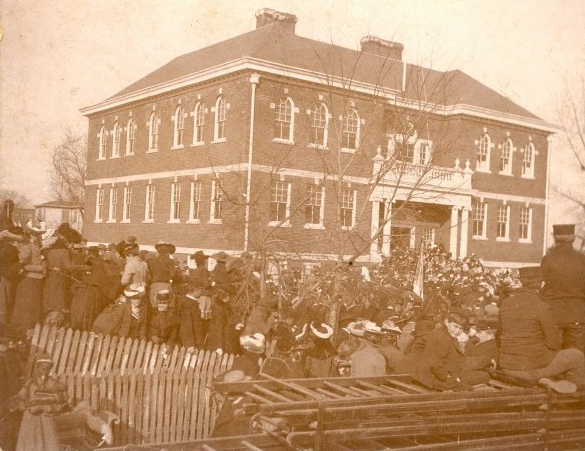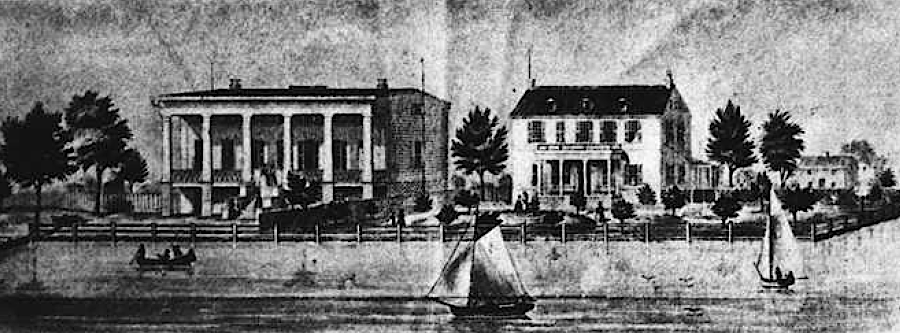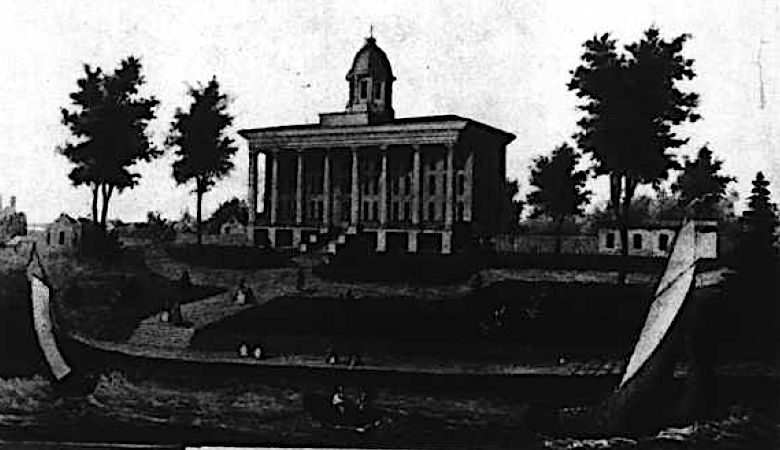
new Syms-Eaton Academy building at its 1901 dedication
Source: Hampton History Museum, Syms-Eaton Academy Opening

new Syms-Eaton Academy building at its 1901 dedication
Source: Hampton History Museum, Syms-Eaton Academy Opening
The first free public school in the United States was founded through the generosity of Benjamin Syms. He lived in what became Isle of Wight County. Evidently he owned land in Elizabeth City County, which is where he donated land and directed the school to be built.
His will, dated February 12, 1634, was signed with an "X." Like the majority of early Virginia colonists, Syms was probably illiterate. He had no wife or children when he died, and chose to donate 200 acres and eight cows in his will for:1
The Syms Free School was operating by 1647.2
Dr. Thomas Eaton mimicked Benjamin Syms and donated 500 acres in 1659 for the separate Eaton Charity School in his 1659 will. He also donated 20 hogs, 12 cows, two bulls, and "two Negroes" for support of the schoolmaster. Dr. Eaton included in his will a requirement that the students had to have been born in Elizabeth City County.
Governor Sir William Berkley's claim in 1671 that there were no free schools in the colony (or printing presses producing news not controlled by his government) is incorrect.
Neither Syms nor Eaton required the students to come from impoverished families; the schools were both intended to be open to all. That approach was more generous the state policy. The Literary Fund created by the General Assembly in 1810 was directed towards the education of just children of poor white people,; not until 1870 were all children offered a free public education.
In 1759, however, the General Assembly prioritized enrollment in the Eaton Charity School to the poor because:3
Both schools taught fundamental reading, writing, and arithmetic to students who today would be enrolled in an elementary school. That reflected Thomas Jefferson's concept of creating "common schools" as part of a statewide system of general education for all white children to become literate, an approach that was not funded by the General Assembly until 1870. Both schools in Elizabeth City County were managed originally by a combination of the justices of the peace and the vestry of the Anglican parish.
In 1760, the Syms Free School trustees leased that tract (minus one acre) to George Wythe for his use during his lifetime. Wythe committed to make an annual payment on February 5 of 31 pounds 5 shillings, provide the school the use of "four good milch cows" between April-November, and plant 100 apple trees to establish a permanent orchard. The lease assured a steady income for the school and the protection of the land from unauthorized use, such as theft of timber.4
After the American Revolution, the Virginia General Assembly disestablished the Anglican Church. The civic responsibilities of the vestries were transferred to the Overseers of the Poor, appointed by the local justices of the peace. The Anglican ministers may have earned a living primarily by teaching at the schools.5
The oversight of the Syms Free School and Eaton Charity School was inadequate in this period, in part because the justices of the peace no longer had as partners the commissioners from the vestry.
In 1803, residents in the Hampton area asked the General Assembly to sell the land held in trust for the two schools and use the proceeds to start a Hampton Academy. By that time the original 700 acres of donated land had expanded to over 1,000 acres, through the addition of Anglican glebe land.
There was a counter-petition by local residents who objected to closing the rural schools near Back River and opening a new school on Cary Street in the town.
In 1805 the legislature agreed to establish Hampton Academy and combine governance of the two schools under one set of 11 trustees, to be elected by the Elizabeth City County voters.
The reason for the General Assembly's action to consolidate the Syms Free School and Eaton Charity School in 1805 was clear:6
The British burned Hampton during the War of 1812, and the Hampton Academy school building was destroyed. Had the Syms Free School and Eaton Charity School not been consolidated and replaced by Hampton Academy, their distance from town would have protected the buildings.
In 1830, rural residents in Elizabeth City County petitioned the General Assembly to use the Syms and Eaton funds to build schools accessible to children who did not live in Hampton. The conflict continued through multiple elections for school trustees and county officials. In 1837 the General Assembly proposed that the state legislature should appoint the trustees and eliminate the authority of local voters. The General Assembly did prohibt trustees from borrowing from school funds for personal use, but rural residents ultimately had to start their own Fox Hill Academy.6
The rivalry became bitter and personal. In 1837 two candidates competed for the position of principal. Each had strong allies in the community, and discussions became acrimonious.
One candidate, George Cooper, and a supporter of his opponent met on Queen Street in Hampton. Neither would move out of the way of the other. Cooper drew a gun. The supporter of his rival, unarmed, dared him to shoot. Cooper did, killing the man, and then fled to New Orleans. Cooper's family later left Hampton to join him there.
The General Assembly appointed trustees for Hampton Academy in 1839, but repealed the law in 1840 and allowed for local voters to choose trustees.7
In 1851, Elizabeth City County voters took advantage of new authorization from the General Assembly and approved creating a local public school system. Local expectations were that he Hampton Academy would be converted into a school governed under the new state law. The trustees extended the life of Hampton Academy by leasing the building to a former schoolmaster. He operated a private school, without the interference of elected or appointed trustees, for several years.
The Syms and Eaton funds were transferred to the new county school system in 1853. In 1855, the private lease ended and the Hampton Academy building became the school house in District No. 3.
There were several other education initiatives in Elizabeth City County during the 1850's. A Baptist minister opened the Chesapeake Female College in 1854. As sectional tensions increased, he converted it into a school for boys. The schoolmaster who had leased Hampton Academy between 1850-1855 also founded the Hampton Military Institute and a school for girls. Both were private, without access to the Syms and Eaton funds, but located adjacent to the Hampton Academy building.8

before the Civil War, the Hampton Military Academy was built next to the Hampton Academy
Source: Southern Workman, The Lower Virginia Peninsula (Volume 32, Number 9, September 1, 1903)

Chesapeake Female College opened in 1854, since the Hampton Academy taught only boys
Source: Southern Workman, The Lower Virginia Peninsula (Volume 32, Number 9, September 1, 1903)
The Confederates burned Hampton on the night of August 7, 1861. The destruction, to prevent the Union Army at Fort Monroe from occupying and using the town as a base, burned the old Hampton Academy building as well as the boys and girls schools next door. The Syms and Eaton endowment, in the form of bonds, was carried to Richmond before the fire.9
In 1868, a separate Hampton Normal and Agricultural Institute was established n Hampton. It was intended to educate people of color. That school, also known as Hampton Institute, has evolved into the current Hampton University.)
The Syms-Eaton fund enabled building a new structure for Hampton Academy in 1870. That building was used as the public school for the white children of Hampton until 1902. The new school building constructed then was called the Syms-Eaton Academy. That building later served as administrative offices of the City of Hampton school system. The site is now the home of Francis W. Jones Middle School.10
What is now Hampton High School still is supported in part by the historic donations of Syms and Eaton. In 2021, the trust fund totaled around $50,000.11